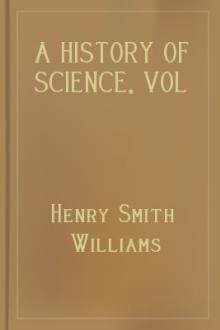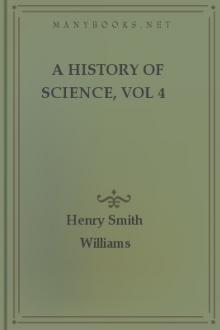A History of Science, vol 1, Henry Smith Williams [read out loud books TXT] 📗

- Author: Henry Smith Williams
- Performer: -
Book online «A History of Science, vol 1, Henry Smith Williams [read out loud books TXT] 📗». Author Henry Smith Williams
Neither are we quite certain as to the precise range of his studies or the exact number of his discoveries. It appears that he had a pupil named Hero, whose personality, unfortunately, is scarcely less obscure than that of his master, but who wrote a book through which the record of the master’s inventions was preserved to posterity. Hero, indeed, wrote several books, though only one of them has been preserved. The ones that are lost bear the following suggestive titles: On the Construction of Slings; On the Construction of Missiles; On the Automaton; On the Method of Lifting Heavy Bodies; On the Dioptric or Spying-tube. The work that remains is called Pneumatics, and so interesting a work it is as to make us doubly regret the loss of its companion volumes.
Had these other books been preserved we should doubtless have a clearer insight than is now possible into some at least of the mechanical problems that exercised the minds of the ancient philosophers. The book that remains is chiefly concerned, as its name implies, with the study of gases, or, rather, with the study of a single gas, this being, of course, the air. But it tells us also of certain studies in the dynamics of water that are most interesting, and for the historian of science most important.
Unfortunately, the pupil of Ctesibius, whatever his ingenuity, was a man with a deficient sense of the ethics of science. He tells us in his preface that the object of his book is to record some ingenious discoveries of others, together with additional discoveries of his own, but nowhere in the book itself does he give us the, slightest clew as to where the line is drawn between the old and the new. Once, in discussing the weight of water, he mentions the law of Archimedes regarding a floating body, but this is the only case in which a scientific principle is traced to its source or in which credit is given to any one for a discovery. This is the more to be regretted because Hero has discussed at some length the theories involved in the treatment of his subject. This reticence on the part of Hero, combined with the fact that such somewhat later writers as Pliny and Vitruvius do not mention Hero’s name, while they frequently mention the name of his master, Ctesibius, has led modern critics to a somewhat sceptical attitude regarding the position of Hero as an actual discoverer.
The man who would coolly appropriate some discoveries of others under cloak of a mere prefatorial reference was perhaps an expounder rather than an innovator, and had, it is shrewdly suspected, not much of his own to offer. Meanwhile, it is tolerably certain that Ctesibius was the discoverer of the principle of the siphon, of the forcing-pump, and of a pneumatic organ. An examination of Hero’s book will show that these are really the chief principles involved in most of the various interesting mechanisms which he describes. We are constrained, then, to believe that the inventive genius who was really responsible for the mechanisms we are about to describe was Ctesibius, the master. Yet we owe a debt of gratitude to Hero, the pupil, for having given wider vogue to these discoveries, and in particular for the discussion of the principles of hydrostatics and pneumatics contained in the introduction to his book. This discussion furnishes us almost our only knowledge as to the progress of Greek philosophers in the field of mechanics since the time of Archimedes.
The main purpose of Hero in his preliminary thesis has to do with the nature of matter, and recalls, therefore, the studies of Anaxagoras and Democritus. Hero, however, approaches his subject from a purely material or practical standpoint. He is an explicit champion of what we nowadays call the molecular theory of matter. “Every body,” he tells us, “is composed of minute particles, between which are empty spaces less than these particles of the body. It is, therefore, erroneous to say that there is no vacuum except by the application of force, and that every space is full either of air or water or some other substance. But in proportion as any one of these particles recedes, some other follows it and fills the vacant space; therefore there is no continuous vacuum, except by the application of some force [like suction]—that is to say, an absolute vacuum is never found, except as it is produced artificially.” Hero brings forward some thoroughly convincing proofs of the thesis he is maintaining. “If there were no void places between the particles of water,” he says, “the rays of light could not penetrate the water; moreover, another liquid, such as wine, could not spread itself through the water, as it is observed to do, were the particles of water absolutely continuous.” The latter illustration is one the validity of which appeals as forcibly to the physicists of to-day as it did to Hero. The same is true of the argument drawn from the compressibility of gases. Hero has evidently made a careful study of this subject. He knows that an inverted tube full of air may be immersed in water without becoming wet on the inside, proving that air is a physical substance; but he knows also that this same air may be caused to expand to a much greater bulk by the application of heat, or may, on the other hand, be condensed by pressure, in which case, as he is well aware, the air exerts force in the attempt to regain its normal bulk. But, he argues, surely we are not to believe that the particles of air expand to fill all the space when the bulk of air as a whole expands under the influence of heat; nor can we conceive that the particles of normal air are in actual contact, else we should not be able to compress the air. Hence his conclusion, which, as we have seen, he makes general in its application to all matter, that there are spaces, or, as he calls them, vacua, between the particles that go to make up all substances, whether liquid, solid, or gaseous.
Here, clearly enough, was the idea of the “atomic” nature of matter accepted as a fundamental notion. The argumentative attitude assumed by Hero shows that the doctrine could not be expected to go unchallenged. But, on the other hand, there is nothing in his phrasing to suggest an intention to claim originality for any phase of the doctrine. We may infer that in the three hundred years that had elapsed since the time of Anaxagoras, that philosopher’s idea of the molecular nature of matter had gained fairly wide currency. As to the expansive power of gas, which Hero describes at some length without giving us a clew to his authorities, we may assume that Ctesibius was an original worker, yet the general facts involved were doubtless much older than his day. Hero, for example, tells us of the cupping-glass used by physicians, which he says is made into a vacuum by burning up the air in it; but this apparatus had probably been long in use, and Hero mentions it not in order to describe the ordinary cupping-glass which is referred to, but a modification of it. He refers to the old form as if it were something familiar to all.
Again, we know that Empedocles studied the pressure of the air in the fifth century B.C., and discovered that it would support a column of water in a closed tube, so this phase of the subject is not new. But there is no hint anywhere before this work of Hero of a clear understanding that the expansive properties of the air when compressed, or when heated, may be made available as a motor power. Hero, however, has the clearest notions on the subject and puts them to the practical test of experiment. Thus he constructs numerous mechanisms in which the expansive power of air under pressure is made to do work, and others in which the same end is accomplished through the expansive power of heated air. For example, the doors of a temple are made to swing open automatically when a fire is lighted on a distant altar, closing again when the fire dies out—effects which must have filled the minds of the pious observers with bewilderment and wonder, serving a most useful purpose for the priests, who alone, we may assume, were in the secret. There were two methods by which this apparatus was worked. In one the heated air pressed on the water in a close retort connected with the altar, forcing water out of the retort into a bucket, which by its weight applied a force through pulleys and ropes that turned the standards on which the temple doors revolved. When the fire died down the air contracted, the water was siphoned back from the bucket, which, being thus lightened, let the doors close again through the action of an ordinary weight. The other method was a slight modification, in which the retort of water was dispensed with and a leather sack like a large football substitued. The ropes and pulleys were connected with this sack, which exerted a pull when the hot air expanded, and which collapsed and thus relaxed its strain when the air cooled. A glance at the illustrations taken from Hero’s book will make the details clear.
Other mechanisms utilized a somewhat different combination of weights, pulleys, and siphons, operated by the expansive power of air, unheated but under pressure, such pressure being applied with a force-pump, or by the weight of water running into a closed receptacle. One such mechanism gives us a constant jet of water or perpetual fountain. Another curious application of the principle furnishes us with an elaborate toy, consisting of a group of birds which alternately whistle or are silent, while an owl seated on a neighboring perch turns towards the birds when their song begins and away from them when it ends. The “singing”
of the birds, it must be explained, is produced by the expulsion of air through tiny tubes passing up through their throats from a tank below. The owl is made to turn by a mechanism similar to that which manipulates the temple doors. The pressure is supplied merely by a stream of running water, and the periodical silence of the birds is due to the fact that this pressure is relieved through the automatic siphoning off of the water when it reaches a certain height. The action of the siphon, it may be added, is correctly explained by Hero as due to the greater weight of the water in the longer arm of the bent tube. As before mentioned, the siphon is repeatedly used in these mechanisms of Hero. The diagram will make clear the exact application of it in the present most ingenious mechanism. We may add that the principle of the whistle was a favorite one of Hero. By the aid of a similar mechanism he brought about the blowing of trumpets when the temple doors were opened, a phenomenon which must greatly have enhanced the mystification. It is possible that this principle was utilized also in connection with statues to produce seemingly supernatural effects. This may be the explanation of the tradition of the speaking statue in the temple of Ammon at Thebes.
{illustration caption = DEVICE FOR CAUSING THE DOORS OF THE
TEMPLE TO OPEN





Comments (0)